文章信息
- 董翠芳, 梁国付, 丁圣彦, 卢训令, 汤茜, 李栋科
- DONG Cuifang, LIANG Guofu, DING Shengyan, LU Xunling, TANG Qian, LI Dongke
- 不同干扰背景下景观指数与物种多样性的多尺度效应——以巩义市为例
- Multi-scale effects for landscape metrics and species diversity under the different disturbance:a case study of Gongyi City
- 生态学报, 2014, 34(12): 3444-3451
- Acta Ecologica Sinica, 2014, 34(12): 3444-3451
- http://dx.doi.org/10.5846/stxb201310302618
-
文章历史
- 收稿日期:2013-10-30
- 修订日期:2014-04-04
2. 河南大学环境与规划学院, 开封 475004
2. College of Environment and Planning, Henan University, Kaifeng 475004, China
空间格局、生态过程和尺度之间的相互作用是景观生态学的研究核心。农业景观可被视为具有高水平生物多样性的生境岛屿植入到集约化利用的农业用地之中的景观镶嵌体[1, 2]。许多研究表明人类活动干扰导致的生境减少和景观结构的变化已成为农业景观中生物多样性丧失的重要原因[3, 4, 5, 6, 7]。生物多样性通过影响生态系统的结构、动态进而影响生态系统功能的发挥,是支撑和调控农业景观生态系统的基础。不同物种与环境变异相互作用的尺度不一样,农业景观生物保护时,在不同尺度上分析就显得尤为重要[8, 9]。因此对尺度的研究受到了很多学者的关注[10, 11, 12]。
以“斑块-廊道-基质”基本理论范式为基础发展起来的景观指数已经成为景观格局分析的重要工具[13]。随着FRAGSTATS等程序包的出现,景观指数在生态学方面的应用越来越广泛,但是景观指数在应用过程中也表现出了一定的局限性,由于缺乏对景观格局与生态过程之间关系的深刻理解,很容易导致景观格局指数的误用[14, 15]。
尺度问题是景观格局分析中的重要议题之一[16, 17, 18]。目前,关于景观结构与物种多样性之间的关系,从不同层次上进行了较多的研究。斑块水平上,很多研究证实了斑块面积、斑块形状等属性特征对栖息于斑块内的植物和动物多样性有重要影响,而对边缘物种和内部物种的影响差别显著[16, 19, 20, 21, 22];森林景观中乔木多样性受景观多样性影响较大,受斑块面积影响较小[23, 24]。景观水平上,景观基质、组成和构型异质性对物种多样性的影响具有较强的尺度依赖性[25, 26, 27]。但是,从多个尺度探讨景观指数对物种多样性的影响还需进一步深入。
巩义市处于黄河中下游低山丘陵——平原区。近年来,一些学者在该区域做了相关研究,如:从农户角度研究了农田生态系统投入和产出特征[28],从尺度上研究了巩义市近年来景观异质性变化和基于景观连接度的森林景观恢复[29],而从不同尺度上探究景观指数与物种多样性关系的相关研究还比较少。本研究集中选取三种自然、半自然生境(灌草丛、人工林和农田边缘)进行植物调查,运用冗余分析(RDA)筛选出对于农业景观中植物多样性有显著影响的景观指数变量,以期理解农业景观结构的变化对植物多样性的影响机制,为今后该区植物多样性的保护提供理论依据。
1 研究区概况巩义市位于河南省中部,伊洛河与黄河汇流处,南依嵩山,北临黄河,地处34°31′—34°52′N,112°49′— 113°17′E之间,地貌上由第2阶梯向第3阶梯过渡,属于豫西山地丘陵地区,为温带季风气候,年平均降水量为583mm,地带性植被是温带落叶阔叶林。研究区主要以农业景观为主,近年来随着土地利用强度的增加,景观类型也发生了很大的变化。
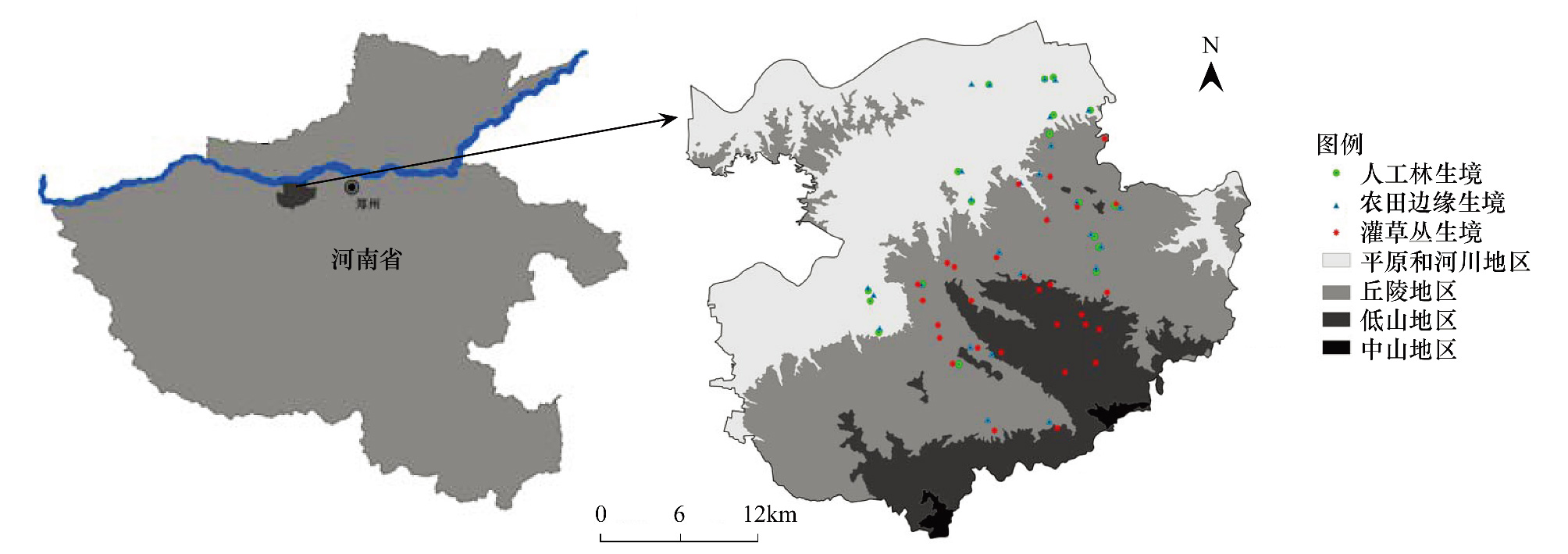
|
| 图 1 研究区采样点分布示意图 Fig.1 Distribution map of sampling sites in study area |
研究数据为2011年巩义市土地利用现状图。景观数据的处理和空间分析主要采用ESRI公司开发的ArcGIS 9.3等软件,景观指数的计算借助于Fragstats 3.3等软件。在野外调查的基础上,依据实际情况,将研究区的景观类型划分为:水浇地景观、旱地景观、果园景观、林地景观、灌木林景观、草地景观、河流景观、坑塘景观、沟渠景观、滩地景观、建设用地景观、道路景观和裸地景观类型,共13种景观类型,基本上能够代表巩义市的实际情况。
本研究在2012年7—8月进行植物群落调查。考虑到巩义的地貌特点和景观分布类型及人为干扰程度,选择具有特色的东南部和南部的山地丘陵地区,共设置43个样点(图 1),生境类型分为3种:灌草丛、人工林、农田边缘;干扰强度从自然生境—半自然生境—人为干扰最强,采用典型样地法进行植物调查。由于受实地情况的限制,每种生境类型设置的样方大小不同,其中,灌草丛共设置29个样地,每个样地5个重复,样方大小为15×10m2;由于农田边界一般都是比较狭长的,进行植物调查时,样方大小为30×1m2;人工林一般都是成片规则分布,样方大小为20×20m2。植物调查时,记录物种的盖度、多优度和高度,同时利用GPS进行地理坐标定位,记录下样方内的海拔、坡度等。
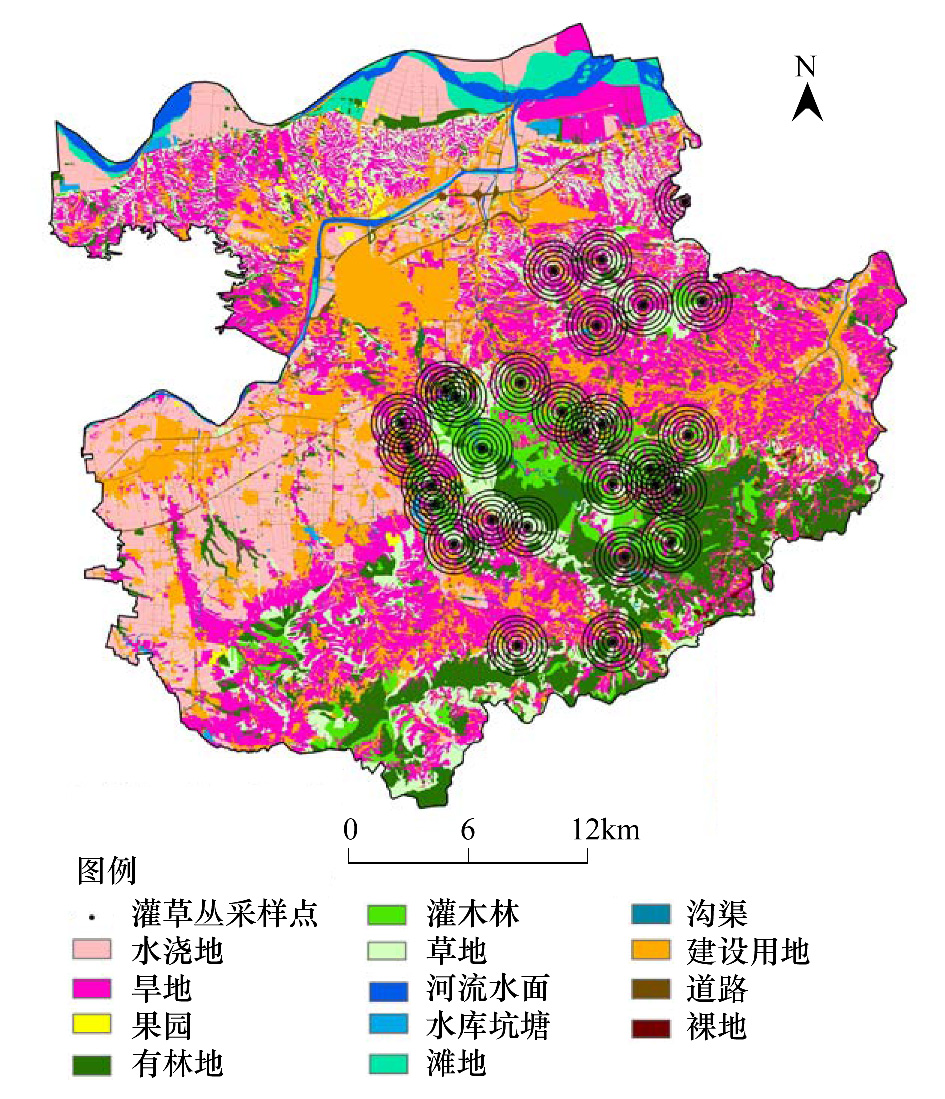
|
| 图 2 缓冲区示意图 (以灌草丛采样点为例) Fig.2 Buffers of sampling sites (A case of shrub habitat) |
分别以样地为中心,设置150、250、500、750、1000、1250、1500m共7个幅度的缓冲区(图 2),从缓冲区内提取出所需的景观指数。本研究选取了景观水平上表征景观斑块形状指数、斑块大小和密度指数、边缘对照指数、邻近度和相似度指数、基质指数以及多样性指数共6类52个指数[30](表 1)。
| 指数名称
Metric name | 数量
Number | 选取指数
Select metric | |
| 类型Ⅰ | 斑块大小、密度指数Patch size and patch density | 8 | |
| TypeⅠ | 斑块面积 Patch Area | 3 | AREA_MN AREA_AM AREA_CV |
| 回转半径 Radius of Gyration | 3 | GYRATE_MN GYRATE_AM GYRATE_CV | |
| 斑块密度 Patch Density | 1 | PD | |
| 最大形状指数 Largest Patch Index | 1 | LPI | |
| 类型Ⅱ | 斑块形状指数Edge and patch shape | 15 | |
| TypeⅡ | 景观形状指数 Landscape Shape Index | 1 | LSI |
| 边缘密度 Edge Density | 1 | ED | |
| 形状指数 Shape Index | 3 | SHAPE_MN SHAPE_AM SHAPE_CV | |
| 周长面积比 Perimeter-Area Ratio | 3 | PARA_MN PARA_AM PARA_CV | |
| 分维度指数 Fractal Dimension Index | 3 | FRAC_MN FRAC_AM FRAC_CV | |
| 邻近指数 Contiguity Index | 3 | CONTIG_MN CONTIG_AM CONGTIG_CV | |
| 周长面积分维度 Perimeter-Area Fractal Dimension | 1 | PAFRAC | |
| 类型Ⅲ | 边缘对照指数Edge contrast | 5 | |
| TypeⅢ | 加权边缘对照密度 Contrast-Weighted Edge Density | 1 | CWED |
| 总边缘对照指数 Total Edge Contrast Index | 1 | TECI | |
| 边缘对照指数 Edge Contrast Index | 3 | ECON | |
| 类型Ⅳ | 邻近度、相似度指数Proximity and similarity | 9 | |
| TypeⅣ | 邻近度指数 Proximity Index | 3 | PROX_MN PROX_AM PROX_CV |
| 相似度指数 Similarity Index | 3 | SIMI_MN SIMI_AM SIMI_CV | |
| 欧式最近邻近距离 Euclidean Nearest Neighbor Distance | 3 | ENN_MN ENN_AM ENN_CV | |
| 类型Ⅴ | 基质指数Texture | 6 | |
| TypeⅤ | 蔓延度指数 Contagion Index | 1 | CONTAG |
| 相邻百分比 Percentage of Like Adjacencies | 1 | PLADJ | |
| 聚集度指数 Aggregation Index | 1 | AI | |
| 散布与并列指数Interspersion & Juxtaposition Ind (%) | 1 | IJI | |
| 景观分割指数 Landscape Division Ind | 1 | DIVISION | |
| 分裂度指数 Splitting Index | 1 | SPLIT | |
| 类型Ⅵ | 景观多样性指数Diversity | 9 | |
| TypeⅥ | 斑块丰富度 Patch Richness | 1 | PR |
| 斑块丰富度密度 Patch Richness Density | 1 | PRD | |
| 斑块相对丰富度 Relative Patch Richness | 1 | RPR | |
| 辛普森多样性指数 Simpson′s Diversity Index | 1 | SIDI | |
| 香农多样性指数 Shannon′s Diversity Index | 1 | SHDI | |
| 修正的辛普森多样性指数Modified Simpson′s Diversity Index | 1 | MSIDI | |
| 香农均匀度指数 Shannon′s Evenness Index | 1 | SHEI | |
| 辛普森均匀度指数Simpson′s Evenness Index | 1 | SIEI | |
| 修正的辛普均匀度指数Modified Simpson′s Evenness Index | 1 | MSIEI | |
| 总和SUM | 52 |
冗余分析(RDA)是直接梯度分析方法中的一种[31],能够有效地对多个景观指数变量进行统计检验,并确定对植物多样性最大解释能力的变量组。借助于Fragstats 3.3提取各个缓冲区内的景观指数,植物多样性与景观指数变量之间的关系采用RDA方法来分析,所有原始数据进行Log转换,变量的显著性均经过499次的Monte Carlo permutation test,这些计算是在CANOCO4.5里完成的。
3 结果分析 3.1 不同生境物种组成的差异性分析植物调查时,每种生境的样点一般都在两种基质分布,灌草丛样点在低山和丘陵地区均有分布,人工林和农田边缘的采样点在平原河川和丘陵地区分布。在分析景观指数与物种多样性之间的尺度效应时,为了说明不同基质对尺度效应无影响,将每种生境的物种组成进行单因子方差分析(图 3)。
结果表明:同一生境类型,不同基质上的物种组成差异不显著,在进行景观指数与物种多样性关系分析时,可以不考虑基质对尺度效应的影响。
3.2 灌草丛群落RDA分析结果通过RDA分析,得出不同半径缓冲区内景观指数对物种多样性的总解释量分别是:26.2%、25.4%、33.6%、32.9%、21.7%、30.4%、26.2%。在分析过程中,将物种重要值(IV)从大到小排序,共划分为6个区间段,分别为:0.1以上、0.05—0.1、0.01—0.05、0.005—0.01、0.001—0.005、0.0005—0.001。从图 4C、D可以看出,在500—750m范围内,SHAPE_AM指数和PARA_AM指数能够很好的解释物种多样性,解释量为33.6%。图 4D、E、F显示出SIDI指数在750—1250m与物种多样性显著相关,而边缘对照指数与基质指数对物种多样性的影响不显著。
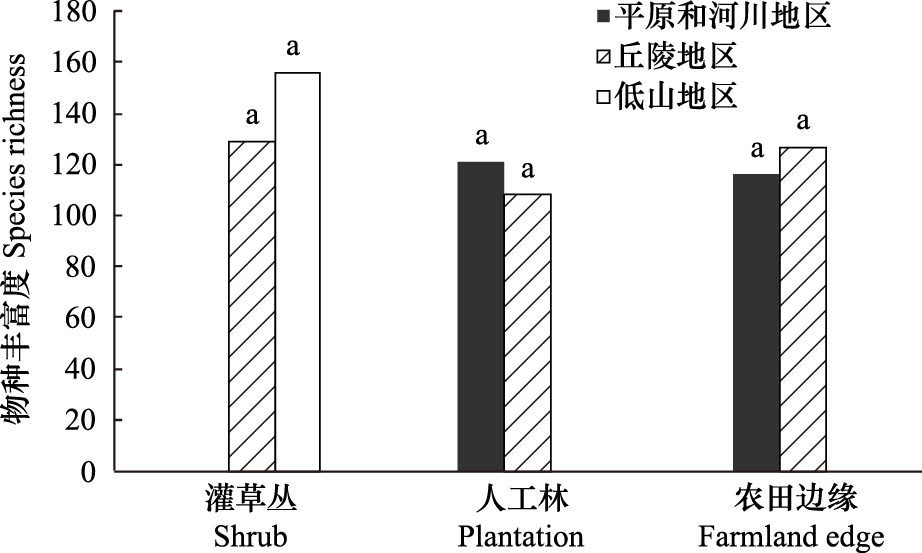
|
| 图 3 各生境不同基质物种组成单因子方差分析α=0.05 Fig.3 Using one-way ANOVA test of significance for species composition of different matrix in each habitat α=0.05 |
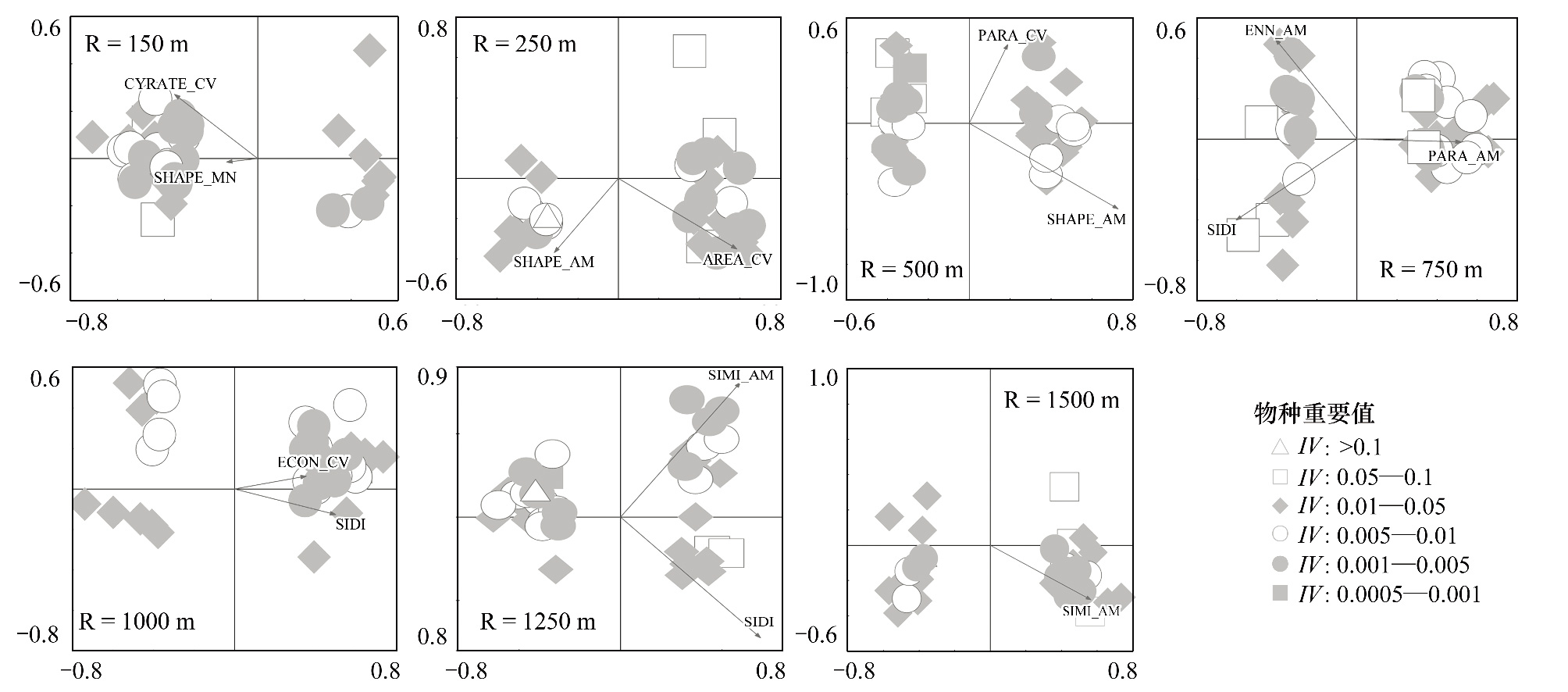
|
| 图 4 灌草丛RDA分析结果 Fig.4 The result of RDA analysis for shrub communities |
通过RDA分析,得出不同半径缓冲区内景观指数对物种多样性的总解释量分别是:31.7%、32.9%、41.6%、30.6%、48.1%、43.6%、33.2%。在分析过程中,将物种重要值(IV)从大到小排序,共划分为5个区间段,分别为:0.1以上、0.05—0.1、0.01—0.05、0.005—0.01、0.001—0.005。关于指数统计分布,与指数的平均值(MN)比较而言,指数的变异系数(CV)和面积加权平均值(AM)能够更好的表征物种多样性。从图中可以看出,SHAPE_AM指数、AREA_CV指数、SIMI指数和PAFRAC指数在1000—1250m范围内,对物种多样性的解释量达到最大,为48.1%,而多样性指数和边缘对照指数对物种多样性几乎没有影响。
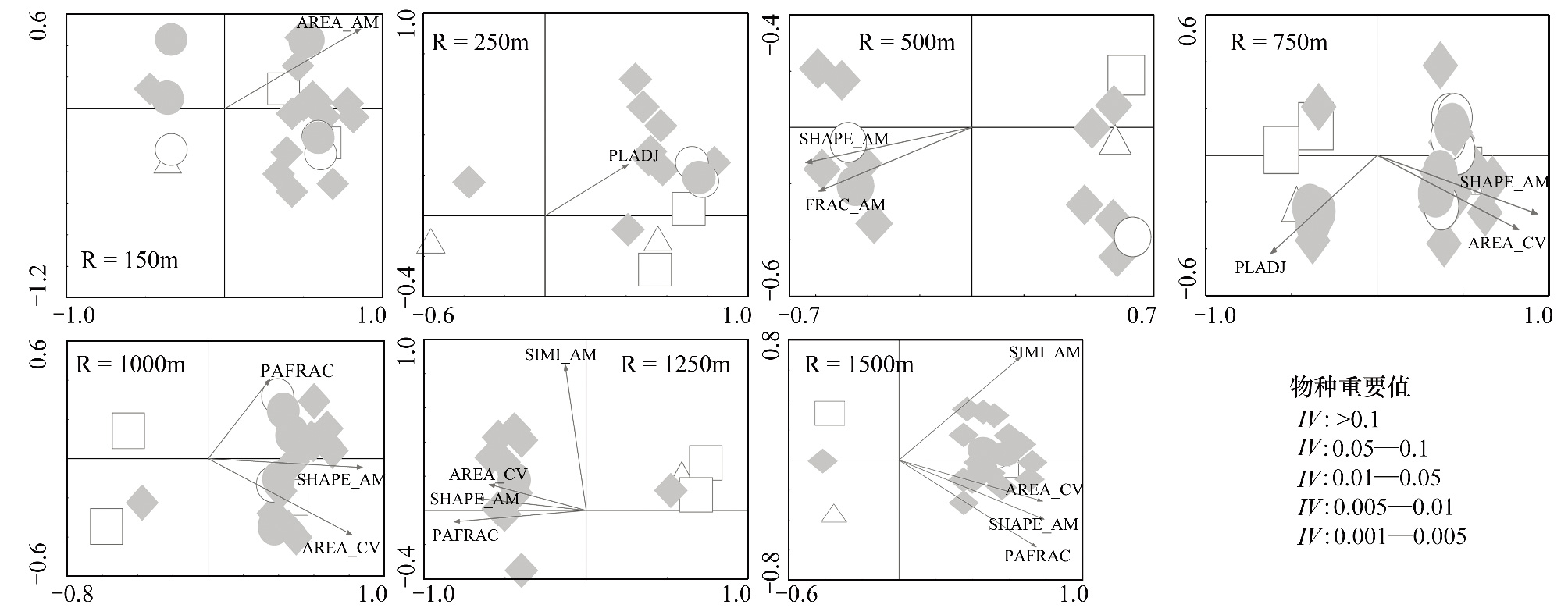
|
| 图 5 人工林RDA分析结果 Fig.5 The result of RDA analysis for plantation communities |
通过RDA分析,得出不同半径缓冲区内景观指数对物种多样性的总解释量分别是:27.4%、25.6%、24.4%、29.4%、28.6%、32.0%、24.3%。在分析过程中,将物种重要值(IV)从大到小排序,共划分为5个区间段,分别为:0.1以上、0.05—0.1、0.01—0.05、0.005—0.01、0.001—0.005。在750—1500m范围内,GYRATE_CV指数、ENN_CV指数、PARA_MN指数和 FRAC_AM指数均对物种多样性影响显著,解释量为32%;而基质指数和景观多样性指数对物种多样性影响较小。

|
| 图 6 农田边缘RDA分析结果 Fig.6 The result of RDA analysis for farmland edge communities |
研究表明,景观指数可以作为测量物种多样性的指标。灌草丛生境,SHAPE_AM指数和PARA_AM指数在500—750m范围内,可以表征物种多样性;人工林生境,在1000—1250m范围内,AREA_CV指数、SHAPE_AM指数、PAFRAC指数和SIMI这些景观指数对物种多样性影响显著;农田边缘生境,GYRATE_CV指数、ENN_CV指数、PARA_MN指数和FRAC_AM指数在 750—1250m对物种多样性影响较大。
生境异质性假说认为大的岛屿或斑块拥有更多的生境斑块因而容纳更多的物种,特别是生境特化种,斑块面积的大小是生境异质性高低的一个表征指标。灌草丛、人工林和农田边缘在一定程度上代表着人类活动干扰强度的增加,由于灌草丛属于近自然生境,受人类干扰很小,景观多样性高。对于3种生境来说,斑块大小和形状指数对植物的分布影响较大,但辛普森多样性指数(SIDI)仅与灌草丛物种多样性在750—1250m范围内作用显著,原因可能是灌草丛的景观多样性高于其他两种生境。斑块的边界形状对生物的影响与边缘效应有关。边界形状不同意味着斑块的边界生境和核心生境的比例不同,由于生物对边界生境和核心生境的需求不同,斑块形状会对生物群落产生影响[32]。Dufour and Honnay等人对西欧植物多样性研究时发现[33, 34],物种多样性均与景观多样性密切相关,受斑块形状影响不显著。Hill and Curran发现加纳乔木物种的分布主要取决于森林破碎化面积,很少与其它景观结构相关[35]。ENN_CV指数只对农田边缘物种多样性作用显著,ENN_CV本身代表着斑块分布的异质性程度。
景观结构对物种多样性的影响很大程度上取决于尺度依赖性,尽管没有一个变量连续的在所有尺度上与物种多样性都显著相关。本研究中,一些指数在较大范围内作用显著,如FRAC_AM、GYRATE_CV和SIMI,原因可能是这些指数统计分布的复杂性只有在较大尺度范围内更敏感。
依据野外实地调查和景观类型图表明,灌草丛零星分布,采样区的灌草丛面积狭长,通过做缓冲区发现,缓冲区越大,就会包含旱地、水浇地、有林地等其他景观类型。结果表明,在灌草丛500—750m左右范围内,SHAPE指数和PARA指数对物种多样性影响显著,可以推断出在这个范围内可能有代表性的斑块或者是主要有灌草丛这一种景观类型,很少有其他景观类型干扰。灌草丛可以划分到自然景观的范畴,这种景观受人类活动的干扰较小,基质连通性高,景观颗粒粗,多数斑块属于环境资源斑块,景观元素间的边界呈曲线状,植物物种丰富。
农田边缘生境,景观指数与物种多样性在750—1250m范围内作用显著,原因可能是为了便于机械化操作,所开发出来的农田斑块都是面积较大、形状比较规则的,如果尺度较小的话,这些指数的敏感性不强。人工林和农田属于由人类的农业活动产生的种植景观。在农田斑块占优势的景观中,镶嵌着村庄和自然或人工生态系统的斑块,斑块的几何化和物种的单纯化是其显著特征。随着人类干扰强度增大,原有分散和形状不规则的斑块向着线形或规则的多边形方向演变,斑块大小、密度和均匀性都会发生变化;道路、树篱等线状廊道的出现使得连通性有所下降,导致栖息于生境内的物种减少。巩义市的人工林大部分是杨树林,受人类干扰强度较大,斑块形状比较规则,加之土壤贫瘠,物种多样性较低,可以通过改造林份、种植国槐等措施将人工林发展为混交林或“近自然林”,使之成为自然、半自然生境,维持较高的生物多样性,促使生态服务功能得到更好地发挥。
| [1] | Wagner H H, Wildi O, Ewald K C. Additive partitioning of plant species diversity in an agricultural mosaic landscape. Landscape Ecology, 2000, 15(3): 219-227. |
| [2] | Fournier E, Loreau M. Respective roles of recent hedges and forest patch remnants in the maintenance of ground-beetle (Coleoptera: Carabidae) diversity in an agricultural landscape. Landscape Ecology, 2001, 16(1):17- 32. |
| [3] | Fahrig L. Effects of habitat fragmentation on biodiversity. Annual Review of Ecology, Evolution and Systematic, 2003, 34: 487-515. |
| [4] | Higgins P A T. Biodiversity loss under existing land use and climate change: an illustration using northern South America. Global Ecology and Biogeography, 2007, 16(2):197-204. |
| [5] | Matson P A, Parton W J, Power A G, Swift M J. Agricultural intensification and ecosystem properties. Science, 1997, 277(5325): 504-509. |
| [6] | Menalled F D, Marino P C, Gage S H, Landis D A. Does agricultural landscape structure affect parasitism and parasitoid diversity? Ecological Applications, 1999, 9(2): 634-641. |
| [7] | Gurr G M, Wratten S D, Luna J M. Multifunction agricultural biodiversity: pest management and other benefits. Basic and Applied Ecology, 2003, 4(2):107-116. |
| [8] | Olff H, Ritchie M E. Fragmented nature: consequences for biodiversity. Landscape and Urban Planning, 2002, 58(2): 83-92. |
| [9] | Tscharntke T, Brandl R. Plant-insect interactions in fragmented landscapes. Annual Reviews in Entomology, 2004, 49(1):405-430. |
| [10] | Holzschuh A, Steffan-Dewenter I, Tscharntke T. Agricultural landscapes with organic crops supports higher pollinator diversity. Oikos, 2008, 117(3): 354-361. |
| [11] | Rundlf M, Bengtsson J, Smith H G. Local and landscape effects of organic farming on butterfly species richness and abundance. Journal of Applied Ecology, 2008, 45(3): 813-820. |
| [12] | Diektter T, Wamser S, Wolters V, Birkhofer K. Landscape and management effects on structure and function of soil arthropod communities in winter wheat. Agriculture, Ecosystems and Environment, 2010, 137(1): 108-112. |
| [13] | Fu B J, Chen LD, Ma K M, Wang Y L. The principle and application of landscape ecology. Beijing: Science Press, 2011:44-45. |
| [14] | Lv Y H, Chen L D, Fu B J. Analysis of integrating approach on landscape pattern and ecological processes. Progress in Geography, 2007, 26(3):1-10. |
| [15] | Li H, Wu J. Use and misuse of landscape indices. Landscape Ecology, 2004, 19(4): 389-399. |
| [16] | Yamaura Y, Kawahara T, Iida S, Ozaki K. Relative importance of the area and shape of patches to the diversity of multiple taxa. Conservation Biology, 2008, 22(6):1513-1522. |
| [17] | Gustafson E J. Quantifying landscape spatial pattern: what is the state of the art? Ecosystems, 1998, 1(2):143-156. |
| [18] | Wu J G. Effects of changing scale on landscape pattern analysis: scaling relations. Landscape Ecology, 2004, 19(2):125-138. |
| [18] | Wu J G. Effects of changing scale on landscape pattern analysis: scaling relations. Landscape Ecology, 2004, 19(2):125-138. |
| [20] | Wagner H H, Edwards P J. Quantifying habitat specificity to assess the contribution of a patch to species richness at a landscape scale. Landscape Ecology, 2001, 16(2): 121 -131. |
| [21] | Moser D, Zechmeister H G, Plutzar C, Sauberer N, Wrbka T, Grabherr G. Landscape patch shape complexity as an effective measure for plant species richness in rural landscapes. Landscape Ecology, 2002, 17(7): 657 -669. |
| [22] | Shi J M, Ma K M, Zhao J Z, Wang J F. The patch characteristics of wetland remnants in the Sanjiang Plain and its influence on plant species richness. Acta Ecologica Sinica, 2010, 30(24): 6683-6690. |
| [23] | Torras O, Gil-Tena A, Saura S. How does forest landscape structure explain tree species richness in a Mediterranean context? Biodiversity and Conservation, 2008, 17(5):1227-1240. |
| [24] | Hernández-Stefanoni J L. The role of landscape patterns of habitat types on plant species diversity of a tropical forest in México. Biodiversity and Conservation, 2006, 15(4): 1441-1458. |
| [25] | Monteiro A T, Fava F, Gonalves J, Huete A, Gusmeroli F, Parolo G, Spano D, Bocchi S. Landscape context determinants to plant diversity in the permanent meadows of Southern European Alps. Biodiversity and Conservation, 2013, 22(4): 937-958. |
| [26] | Schindler S, von Wehrden H, Poirazidis K, Wrbka T, Kati V. Multiscale performance of landscape metrics as indicators of species richness of plants, insects and vertebrates. Ecological Indicators, 2013, 31:41-48. |
| [27] | Fahrig L, Baudry J, Brotons L, Burel F G, Crist T O, Fuller R J, Sirami C, Siriwardena G M, Martin J L. Functional landscape heterogeneity and animal biodiversity in agricultural landscapes. Ecology Letters, 2011, 14(2): 101-112. |
| [28] | Li X J, Qiao J J. Impact of landform on input-output for man-land system in farmland of mountainous region: a micro-study of a small village in Wugou of Henan Province. Geographical Research, 2004, 23(6): 717-727. |
| [29] | Chen J, Liang G F, Ding S Y. Landscape connectivity analysis for the forest landscape restoration: a case study of Gongyi City. Acta Ecologica Sinica,2012, 32(12): 3773-3781. |
| [30] | Schindler S, Poirazidis K, Wrbka T. Towards a core set of landscape metrics for biodiversity assessments: A case study from Dadia National Park, Greece. Ecological Indicators, 2008, 8(5):502-514. |
| [31] | Ter Braak C J F, Smilauer F P. CANOCO reference manual and CanoDraw for Windows. User′s guide: software for Canonical Ordination. (version4.5).New York: Microcomputer power, Ithaca, 2002. |
| [32] | Liu Y H, Li L T, Yu Z R. Landscape planning approaches for biodiversity conservation in agriculuture.Chinese Journal of Applied Ecology, 2008, 19(11):2538-2543. |
| [33] | Dufour A, Gadallah F, Wagner H H, Guisan A, Buttler A. Plant species richness and environmental heterogeneity in a mountain landscape: effects of variability and spatial conguration. Ecography, 2006, 29 (4):573-584. |
| [34] | Honnay O, Piessens K, Van Landuyt W, Hermy M, Gulinck H. Satellite based land use and landscape complexity indices as predictors for regional plant species diversity. Landscape and Urban Planning, 2003, 63(4): 241-250. |
| [35] | Hill J L, Curran P J. Area, shape and isolation of tropical forest fragments: effects on tree species diversity and implications for conservation. Journal of Biogeography, 2003, 30 (9):1391-1403. |
| [35] | Hill J L, Curran P J. Area, shape and isolation of tropical forest fragments: effects on tree species diversity and implications for conservation. Journal of Biogeography, 2003, 30 (9):1391-1403. |
| [14] | 吕一河, 陈利顶, 傅伯杰. 景观格局与生态过程的耦合途径分析. 地理科学进展, 2007, 26(3):1-10. |
| [22] | 施建敏,马克明,赵景柱,王继丰.三江平原残存湿地斑块特征及其对物种多样性的影响.生态学报,2010,30(24) : 6683-6690. |
| [28] | 李小建, 乔家君. 地形对山区农田人地系统投入产出影响的微观分析——河南省巩义市吴沟村的实证研究. 地理研究, 2004, 23(6): 717-727. |
| [29] | 陈杰,梁国付,丁圣彦. 基于景观连接度的森林景观恢复研究——以巩义市为例.生态学报,2012,32(12): 3773-3781. |
| [32] | 刘云慧,李良涛, 宇振荣. 农业生物多样性保护的景观规划途径. 应用生态学报,2008,19(11):2538-2543. |
 2014, Vol. 34
2014, Vol. 34




